Abstract
A comparison of toluene and ethanol (EtOH) induced changes in central nervous system (CNS) function and symptoms were evaluated in two studies, and when possible the effects of toluene were expressed in EtOH equivalent units. The toluene concentrations were 0, 75, and 150 ppm, bracketing the American Conference of Governmental Industrial Hygienists threshold limit value (ACGIH TLV) of 100 ppm. The socially relevant EtOH doses were 0.00, 0.33, and 0.66 g EtOH/kg body weight, equivalent to two and four 3.5% 12 ounce beers. Forty two paid college students were used in each study. In the first study, subjects were exposed to toluene and an odour masking agent menthol (0.078 ppm) for seven hours over three days. In the second study EtOH or a placebo was administered at 1530 across three days also in the presence of menthol. Verbal and visual short term memory (Sternberg, digit span, Benton, pattern memory), perception (pattern recognition), psychomotor skill (simple reaction time, continuous performance, symbol-digit, hand-eye coordination, finger tapping, and critical tracking), manual dexterity (one hole), mood (profile on mood scales (POMS), fatigue (fatigue checklist), and verbal ability were evaluated at 0800, 1200, and 1600. Voluntary symptoms and observations of sleep were collected daily. A 3 x 3 latin square design evaluated solvent effects simultaneously controlling for learning and dose sequence. An analysis of variance and test for trend were performed on am-pm differences reflecting an eight hour workday and on pm scores for each solvent, in which subjects were their own control Intersubject variation in absorbance was monitored in breath. A 5 to 10% decrement was considered meaningful if consistent with a linear trend at p less than 0.05. At 150 ppm toluene, losses in performance were 6.0% for digit span, 12.1% for pattern recognition (latency), 5% for pattern memory (number correct), 6.5% for one hole, and 3% for critical tracking. The number of headaches and eye irritation also increased in a dose-response manner. The greatest effect was found for an increasing number of observations of sleep. A range of 2 to 7% decrements suggest the ACGIH TLV of 100 ppm toluene may be a good estimate of the biological threshold supporting a re-evaluation of the TLV. At 0.66 g EtOH/kg body weight symptoms and performance decrements were 6.6% for digit span, 9.2% for pattern recognition, 4.0% for continuous performance, 7.9% for symbol-digit, 16.5% for finger tapping, 6.2% for critical tracking, and 5.2% for the one hole test. The EtOH equivalents at 150 ppm toluene for digit span (0.56g EtOH/kg/body weight), the latency for pattern recognition (0.66 g EtOH kg body weight), and the one hole element "move" (0.37 g EtOH kg body weight) show that the first two measures would be affected at or above the 50 mg% blood alcohol concentration. This concentration is recognised as the lowest alcohol concentration associated with increased numbers of automobile accidents. The results suggest that EtOH may be a useful acute standard to compare the effects of various industrial solvents and support investigating an association between exposure to solvents and increased risk to safety in industry.
Full text
PDF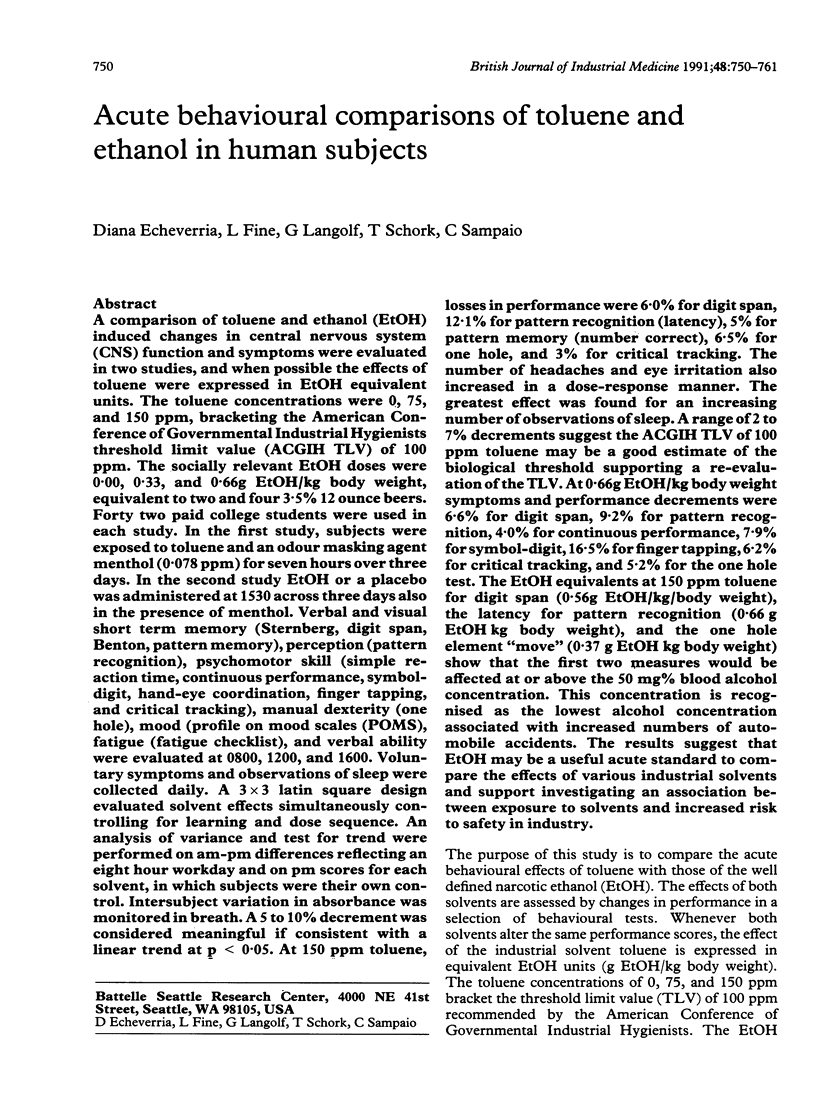

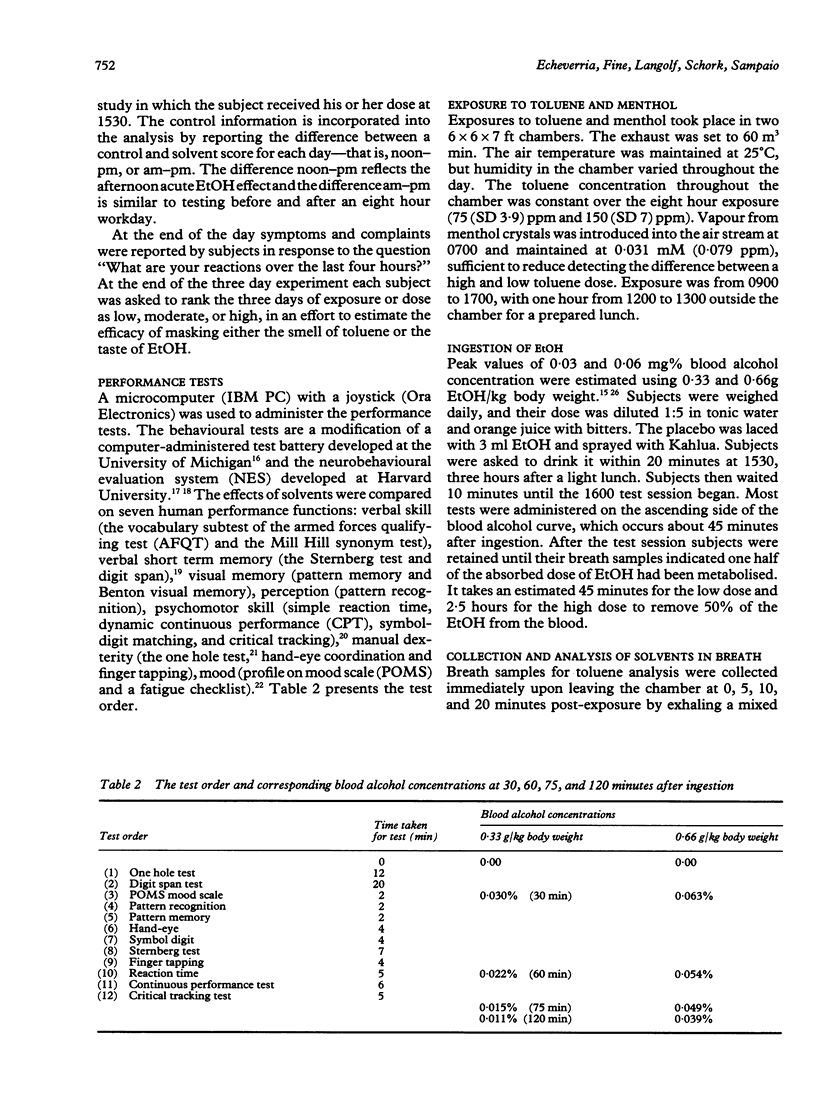
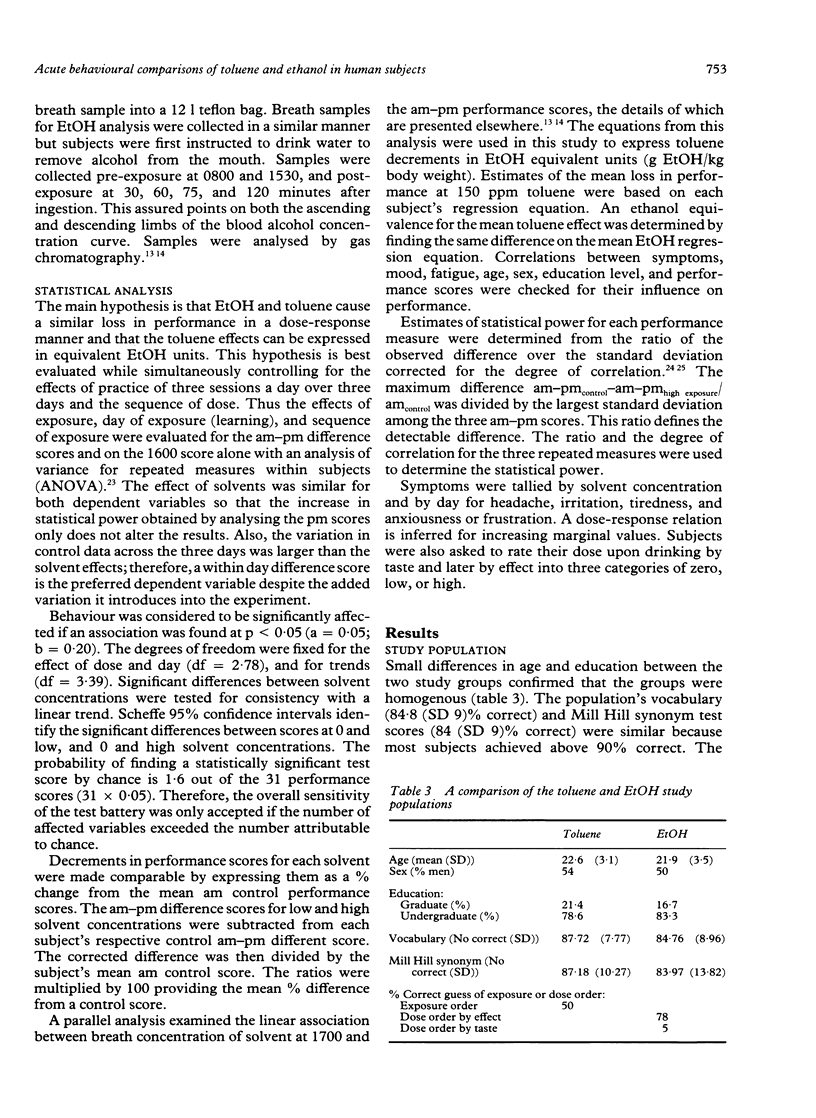
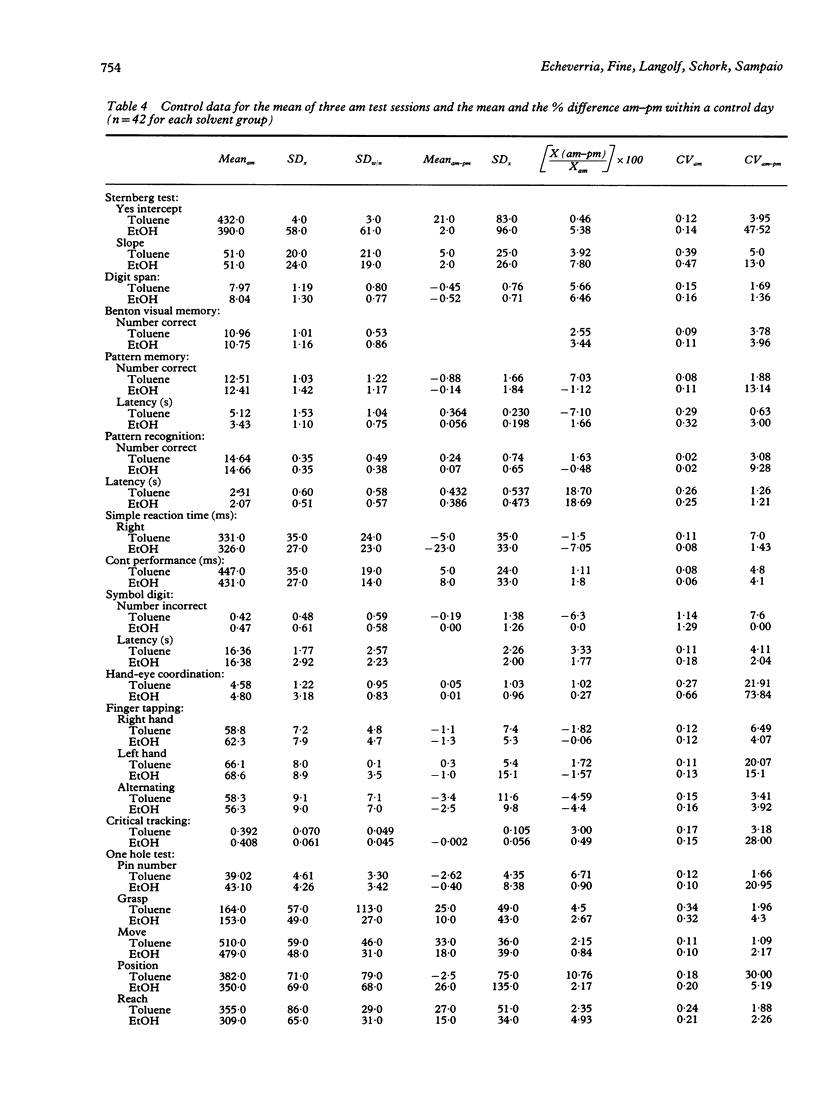
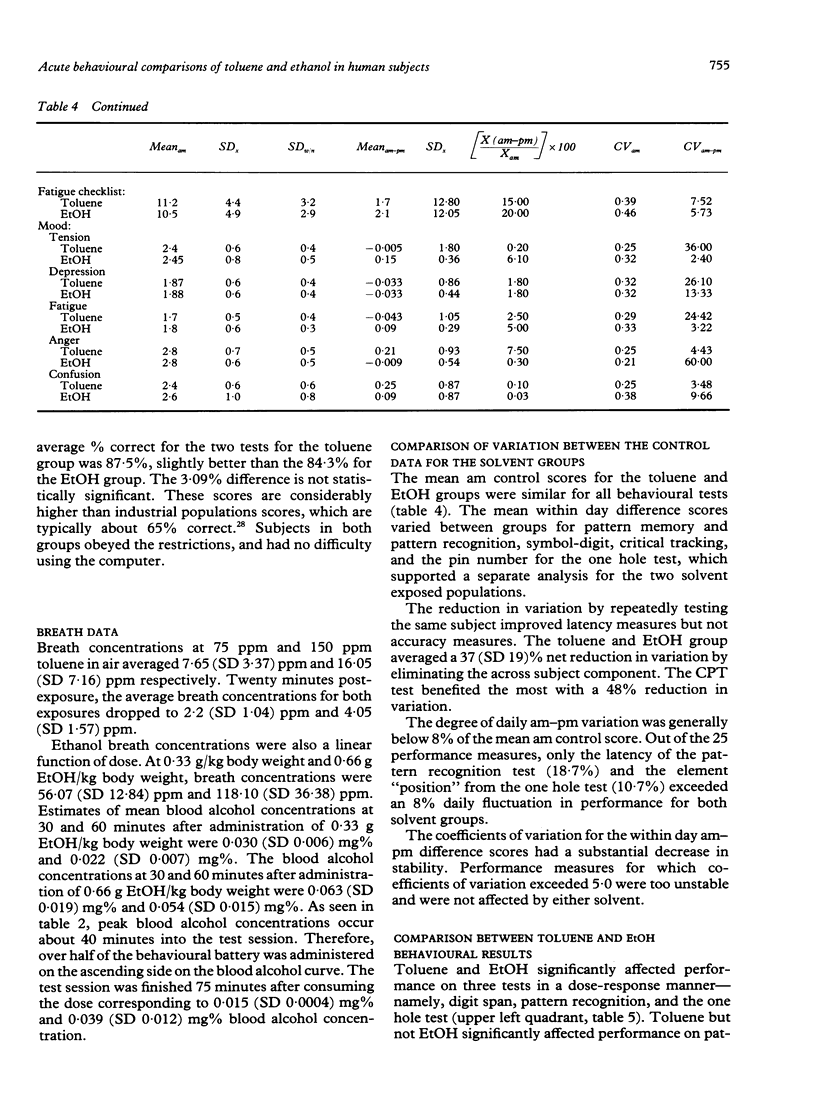
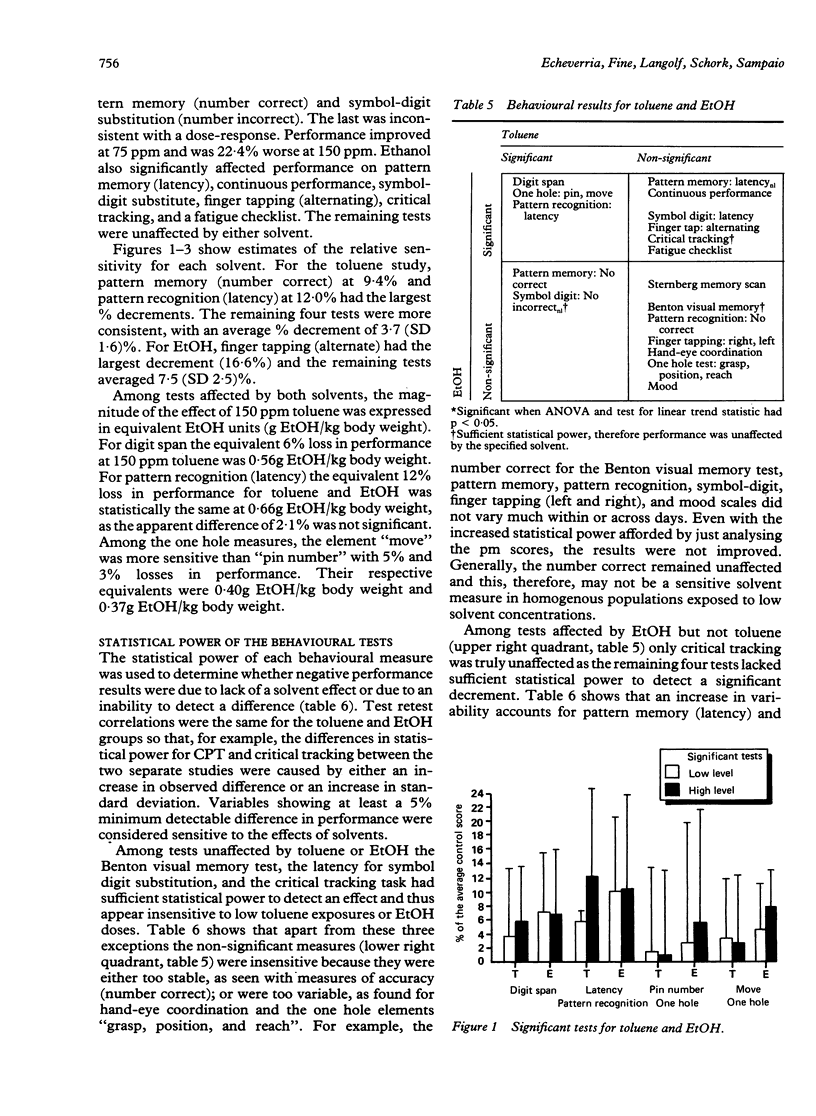
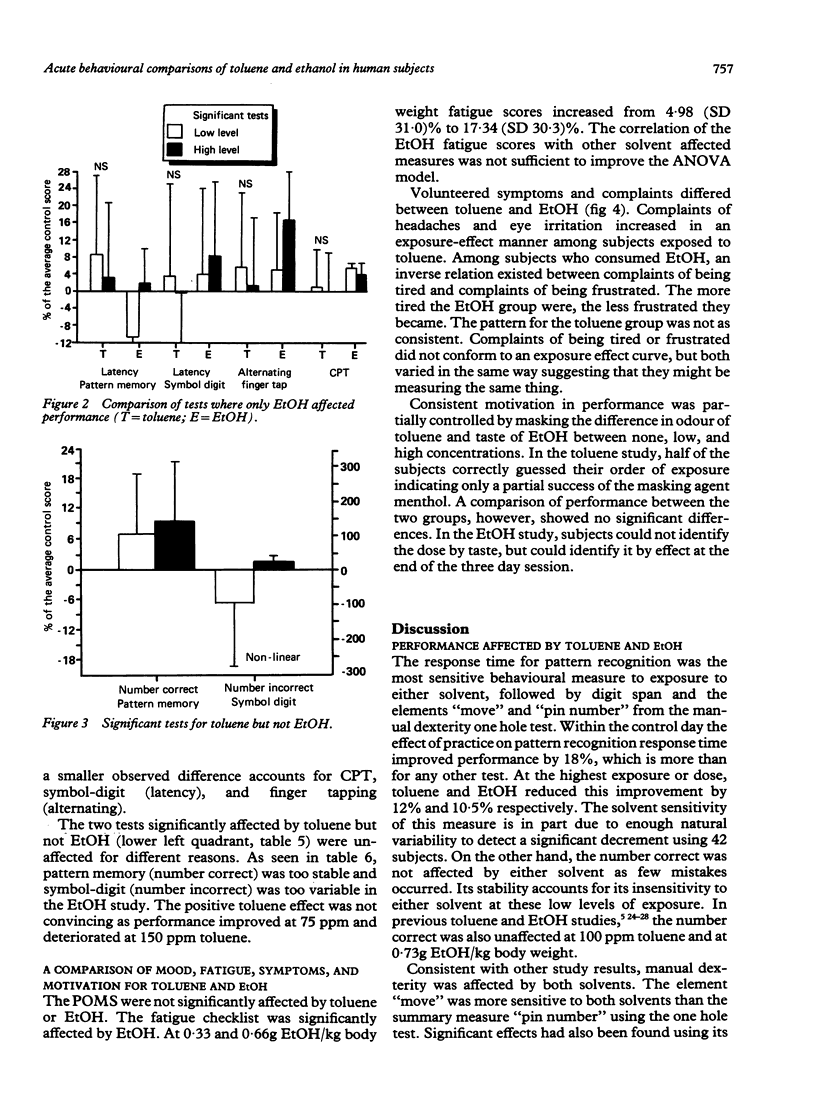
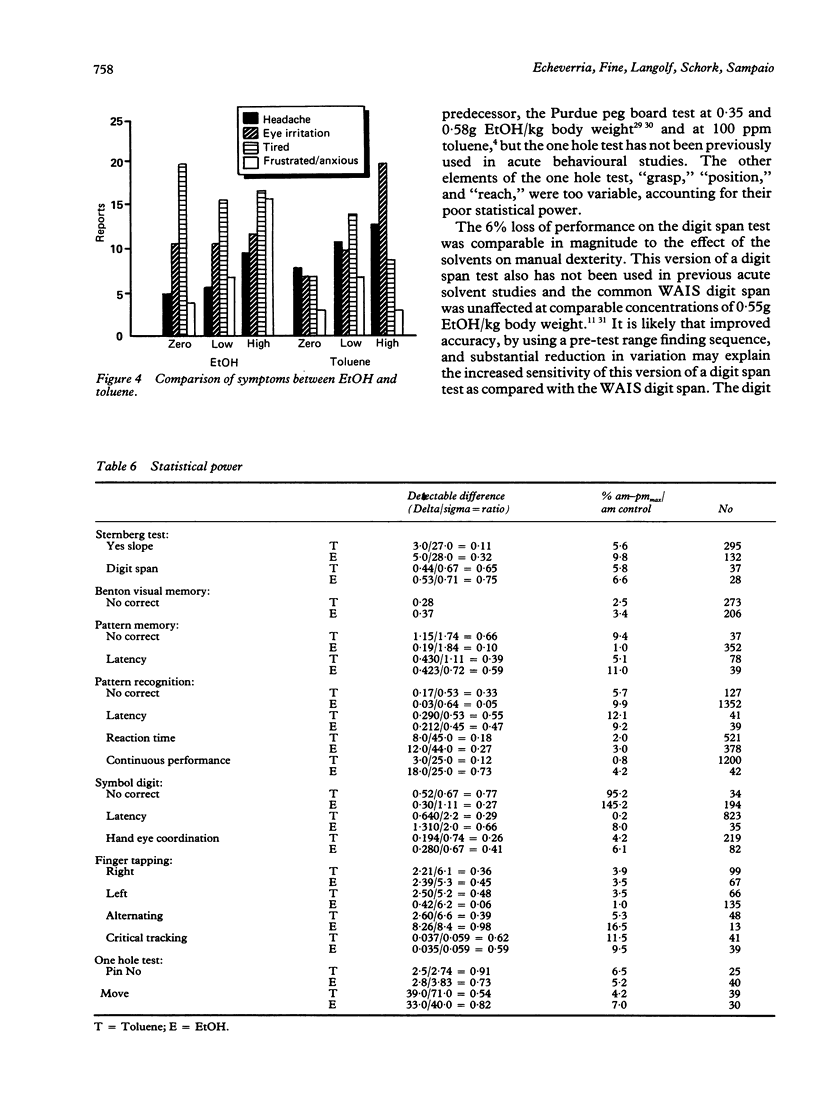
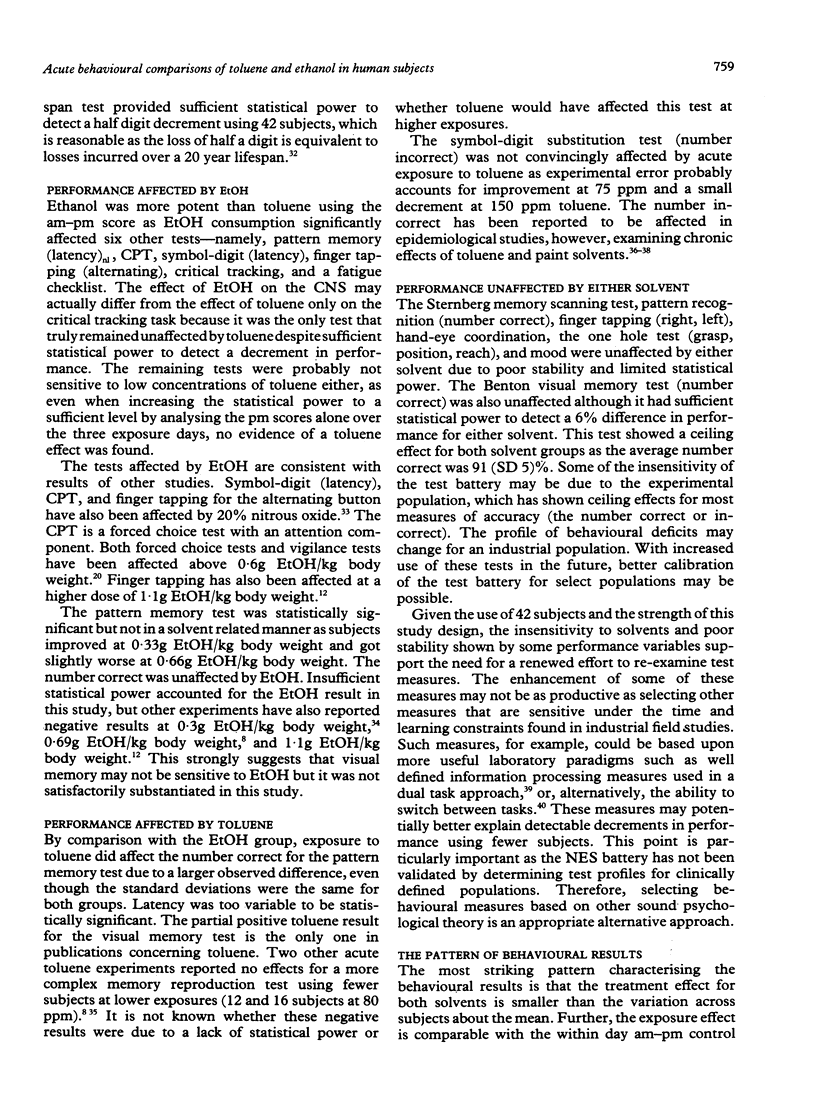
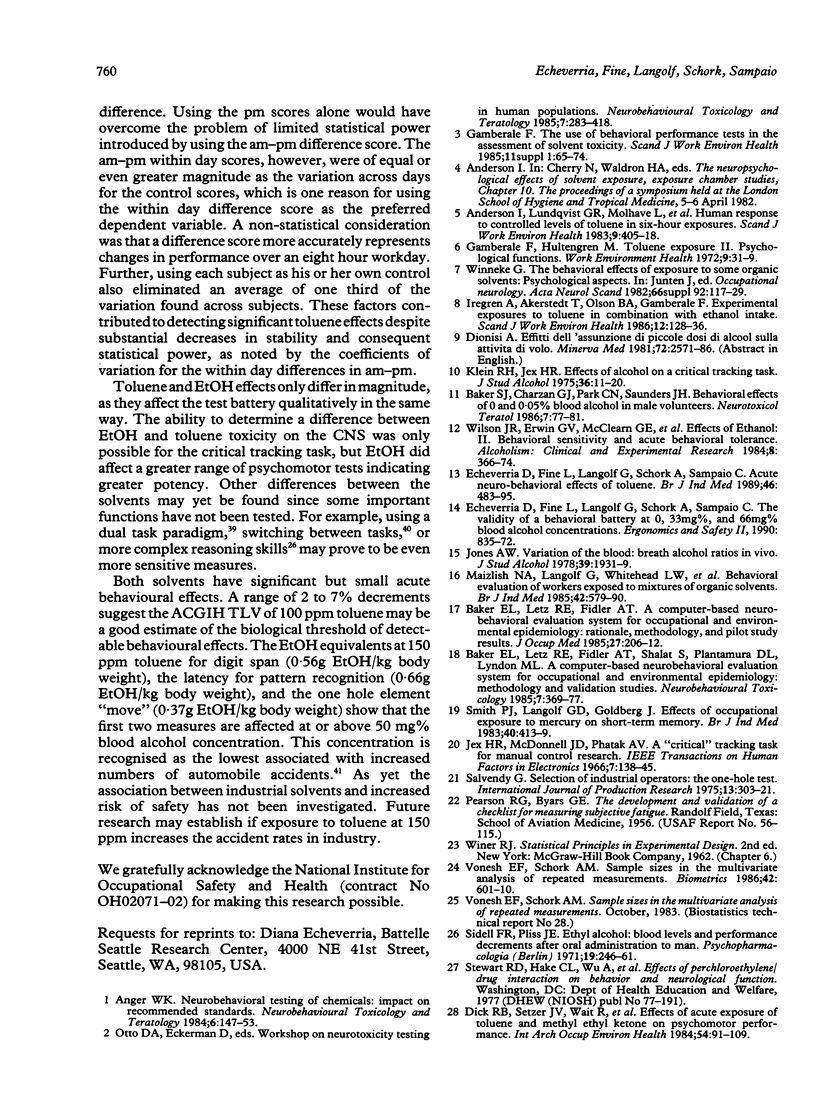
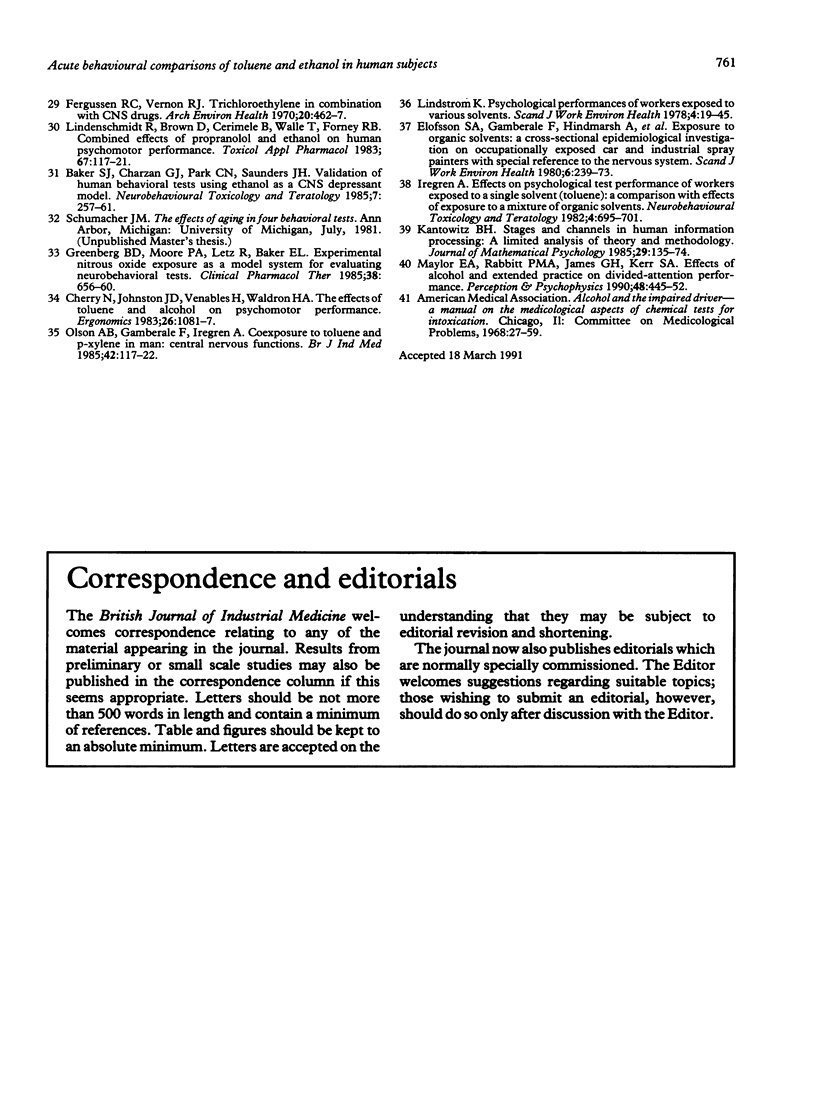
Selected References
These references are in PubMed. This may not be the complete list of references from this article.
- Andersen I., Lundqvist G. R., Mølhave L., Pedersen O. F., Proctor D. F., Vaeth M., Wyon D. P. Human response to controlled levels of toluene in six-hour exposures. Scand J Work Environ Health. 1983 Oct;9(5):405–418. doi: 10.5271/sjweh.2393. [DOI] [PubMed] [Google Scholar]
- Anger W. K. Neurobehavioral testing of chemicals: impact on recommended standards. Neurobehav Toxicol Teratol. 1984 Mar-Apr;6(2):147–153. [PubMed] [Google Scholar]
- Baker E. L., Letz R. E., Fidler A. T., Shalat S., Plantamura D., Lyndon M. A computer-based neurobehavioral evaluation system for occupational and environmental epidemiology: methodology and validation studies. Neurobehav Toxicol Teratol. 1985 Jul-Aug;7(4):369–377. [PubMed] [Google Scholar]
- Baker E. L., Letz R., Fidler A. A computer-administered neurobehavioral evaluation system for occupational and environmental epidemiology. Rationale, methodology, and pilot study results. J Occup Med. 1985 Mar;27(3):206–212. [PubMed] [Google Scholar]
- Baker S. J., Chrzan G. J., Park C. N., Saunders J. H. Behavioral effects of 0 and 0.05% blood alcohol in male volunteers. Neurobehav Toxicol Teratol. 1986 Jan-Feb;8(1):77–81. [PubMed] [Google Scholar]
- Baker S. J., Chrzan G. J., Park C. N., Saunders J. H. Validation of human behavioral tests using ethanol as a CNS depressant model. Neurobehav Toxicol Teratol. 1985 May-Jun;7(3):257–261. [PubMed] [Google Scholar]
- Cherry N., Johnston J. D., Venables H., Waldron H. A., Buck L., MacKay C. J. The effects of toluene and alcohol on psychomotor performance. Ergonomics. 1983 Nov;26(11):1081–1087. doi: 10.1080/00140138308963441. [DOI] [PubMed] [Google Scholar]
- Dick R. B., Setzer J. V., Wait R., Hayden M. B., Taylor B. J., Tolos B., Putz-Anderson V. Effects of acute exposure of toluene and methyl ethyl ketone on psychomotor performance. Int Arch Occup Environ Health. 1984;54(2):91–109. doi: 10.1007/BF00378512. [DOI] [PubMed] [Google Scholar]
- Dionisi A. Effetti dell'assunzione di piccole dosi di alcool sulla attività di volo. Minerva Med. 1981 Oct 6;72(38):2571–2586. [PubMed] [Google Scholar]
- Echeverria D., Fine L., Langolf G., Schork A., Sampaio C. Acute neurobehavioural effects of toluene. Br J Ind Med. 1989 Jul;46(7):483–495. doi: 10.1136/oem.46.7.483. [DOI] [PMC free article] [PubMed] [Google Scholar]
- Elofsson S. A., Gamberale F., Hindmarsh T., Iregren A., Isaksson A., Johnsson I., Knave B., Lydahl E., Mindus P., Persson H. E. Exposure to organic solvents. A cross-sectional epidemiologic investigation on occupationally exposed care and industrial spray painters with special reference to the nervous system. Scand J Work Environ Health. 1980 Dec;6(4):239–273. doi: 10.5271/sjweh.2609. [DOI] [PubMed] [Google Scholar]
- Ferguson R. K., Vernon R. J. Trichloroethylene in combination with CNS drugs. Effects on visual-motor tests. Arch Environ Health. 1970 Apr;20(4):462–467. doi: 10.1080/00039896.1970.10665623. [DOI] [PubMed] [Google Scholar]
- Gamberale F. Use of behavioral performance tests in the assessment of solvent toxicity. Scand J Work Environ Health. 1985;11 (Suppl 1):65–74. [PubMed] [Google Scholar]
- Greenberg B. D., Moore P. A., Letz R., Baker E. L. Computerized assessment of human neurotoxicity: sensitivity to nitrous oxide exposure. Clin Pharmacol Ther. 1985 Dec;38(6):656–660. doi: 10.1038/clpt.1985.241. [DOI] [PubMed] [Google Scholar]
- Iregren A., Akerstedt T., Anshelm Olson B., Gamberale F. Experimental exposure to toluene in combination with ethanol intake. Psychophysiological functions. Scand J Work Environ Health. 1986 Apr;12(2):128–136. doi: 10.5271/sjweh.2167. [DOI] [PubMed] [Google Scholar]
- Iregren A. Effects on psychological test performance of workers exposed to a single solvent (toluene)--a comparison with effects of exposure to a mixture of organic solvents. Neurobehav Toxicol Teratol. 1982 Nov-Dec;4(6):695–701. [PubMed] [Google Scholar]
- Jones A. W. Variability of the blood:breath alcohol ratio in vivo. J Stud Alcohol. 1978 Nov;39(11):1931–1939. doi: 10.15288/jsa.1978.39.1931. [DOI] [PubMed] [Google Scholar]
- Klein R. H., Jex H. R. Effects of alcohol on a Critical Tracking Task. J Stud Alcohol. 1975 Jan;36(1):11–20. doi: 10.15288/jsa.1975.36.11. [DOI] [PubMed] [Google Scholar]
- Knave B., Olson B. A., Elofsson S., Gamberale F., Isaksson A., Mindus P., Persson H. E., Struwe G., Wennberg A., Westerholm P. Long-term exposure to jet fuel. II. A cross-sectional epidemiologic investigation on occupationally exposed industrial workers with special reference to the nervous system. Scand J Work Environ Health. 1978 Mar;4(1):19–45. doi: 10.5271/sjweh.2725. [DOI] [PubMed] [Google Scholar]
- Lindenschmidt R., Brown D., Cerimele B., Walle T., Forney R. B. Combined effects of propranolol and ethanol on human psychomotor performance. Toxicol Appl Pharmacol. 1983 Jan;67(1):117–121. doi: 10.1016/0041-008x(83)90250-8. [DOI] [PubMed] [Google Scholar]
- Maizlish N. A., Langolf G. D., Whitehead L. W., Fine L. J., Albers J. W., Goldberg J., Smith P. Behavioural evaluation of workers exposed to mixtures of organic solvents. Br J Ind Med. 1985 Sep;42(9):579–590. doi: 10.1136/oem.42.9.579. [DOI] [PMC free article] [PubMed] [Google Scholar]
- Maylor E. A., Rabbitt P. M., James G. H., Kerr S. A. Effects of alcohol and extended practice on divided-attention performance. Percept Psychophys. 1990 Nov;48(5):445–452. doi: 10.3758/bf03211588. [DOI] [PubMed] [Google Scholar]
- Sidell F. R., Pless J. E. Ethyl alcohol: blood levels and performance decrements after oral administration to man. Psychopharmacologia. 1971;19(3):246–261. doi: 10.1007/BF00401941. [DOI] [PubMed] [Google Scholar]
- Smith P. J., Langolf G. D., Goldberg J. Effect of occupational exposure to elemental mercury on short term memory. Br J Ind Med. 1983 Nov;40(4):413–419. doi: 10.1136/oem.40.4.413. [DOI] [PMC free article] [PubMed] [Google Scholar]
- Vonesh E. F., Schork M. A. Sample sizes in the multivariate analysis of repeated measurements. Biometrics. 1986 Sep;42(3):601–610. [PubMed] [Google Scholar]
- Wilson J. R., Erwin V. G., McClearn G. E., Plomin R., Johnson R. C., Ahern F. M., Cole R. E. Effects of ethanol: II. Behavioral sensitivity and acute behavioral tolerance. Alcohol Clin Exp Res. 1984 Jul-Aug;8(4):366–374. doi: 10.1111/j.1530-0277.1984.tb05682.x. [DOI] [PubMed] [Google Scholar]
- Winneke G. Acute behavioral effects of exposure to some organic solvents -psychophysiological aspects. Acta Neurol Scand Suppl. 1982;92:117–129. [PubMed] [Google Scholar]


